|
Related FAQs: Coralline Algae, Coralline Algae 2, Coralline Algae 3, Coralline Algae 4, Coralline Algae Identification, Coralline Algae Behavior, Coralline Algae Compatibility/Control,
Coralline Algae Selection,
Coralline Algae Systems,
Coralline Algae Nutrition,
Coralline Algae Disease,
Coralline Algae
Reproduction/Propagation, Red Algae in
General, Red Algae
2, Red Algae
Identification, Red Algae
Behavior, Red Algae
Compatibility, Red Algae
Selection, Red Algae Systems,
Red Algae Nutrition, Red Algae Disease, Red Algae Reproduction/Propagation,
Marine Algae ID 1, Marine Algae ID 2, Marine Algae Control FAQs II, Marine Algaecide Use, Nutrient Limitation, Marine Algae Eaters, Culturing Macro-Algae; Controlling: BGA/Cyano, Red/Encrusting Algae, Green Algae, Brown/Diatom Algae,
Related Articles: Marine Macro-Algae, Calcium and Alkalinity
Explained, Avoiding
Algae Problems in Marine
System, Algae
Control, Marine Maintenance,
Marine Scavengers, Snails, Hermit
Crabs, Mithrax/Emerald
Green Crabs, Sea Urchins, Blennies, Algae
Filters, Ctenochaetus/Bristle Mouth
Tangs, Zebrasoma/Sailfin Tangs,
Skimmers, Skimmer Selection, Marine Algae, Coralline Algae, Green Algae, Brown
Algae, Blue-Green
"Algae"/(Cyanobacteria), Diatoms, Brown
Algae,
/A Diversity of Aquatic
Life
Coralline Algae: Use in Marine Aquariums
|
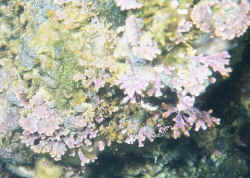
|
|
By Bob Fenner
|
Lithophyllum
in the Sea of Cortez
|
 |
New Print and
eBook on Amazon
Marine Aquarium Algae Control
by Robert (Bob) Fenner
|
The encrusting Red Algae of marine aquariums are mainly
of the non-jointed calcareous Subfamily Melobesioideae
("Mellow-beas-ee-dfpoy-day-ee"), in the Family Corallinacae
(Order Cryptonemiales); they appear as thin crusts or nodular ridges.
On close observation these films of cells are composed of calcite
shells. Commonly seen are Lithophyllum, Porolithon (a
major component of many algal reefs), Melobesia and
Lithothamnion.
The branched forms of calcareous red algae are mainly members of the
Corallinaceae as well; but in a different Subfamily, the
Corallinoideae, comprising the jointed (or articulated) corallines.
Both groups are worldwide and common in tropical to sub-tropical seas.
Most often seen are the genera Corallina &
Bossiella.
Bigger PIX:
The images in this table are linked to large
(desktop size) copies. Click on "framed" images to go to
the larger size. |
|
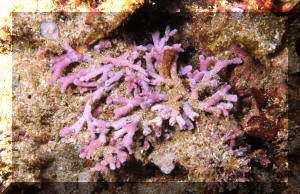
|
Other forms of red algae are more typically soft and
string-like or flat sheets in body (thallus) shape and flexible in
texture.
|
Peyssonnelia sp.
Baltimore Aquarium
|
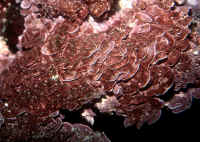
|
Bigger PIX:
The images in this table are linked to large (desktop size) copies.
Click on "framed" images to go to the larger size. |
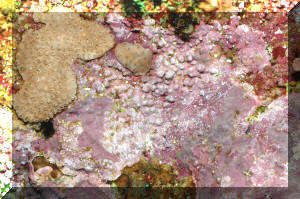
MD.JPG)

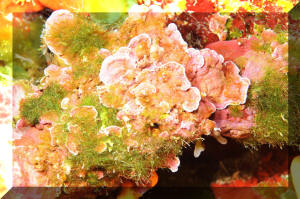
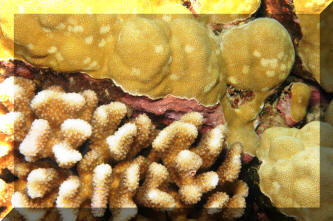
%20MD.JPG) |
|
Your book is available in the Kindle Store! – 09/10/13
Oh yes; a new e-book on marine algae and their control in
aquariums; can be borrowed for free w/ Kindle, for Prime
members. Enjoy. B
Congratulations, your book "Marine Aquarium Algae Control"
is live in the Kindle Store and has been enrolled in KDP Select. It is
available* for readers to purchase
here.
|
More coralline growth please. I need it now and I need
it fast! - 3/31/04 I ordered life rock from live aquaria and
it seems like it's really taking a long time to grow coralline
algae or really anything at all. <Is the tank fairly new??> it is
still brown, green, and white. I had the live rock for six weeks.
<Hardly enough time for coralline growth, my friend. One thing that
I can tell you from my experience is that it usually takes a well
established tank (aged) before rapid growth occurs. Also, lots and lots
of patience. Nothing happens in fast forward in reef aquaria except
deterioration and destruction. Please look at our FAQs on coralline
algae for more information. Also there are some things you can do to
speed up the process slightly. Here is some info I have gleaned from
GARF and other sources: The answer comes in four stages, lighting,
supplementation, GARF'S grunge product (lots of coralline
diversity) and the most important ingredient..........PATIENCE.
COOK BOOK METHOD FOR GROWING CORALLINE FASTER Use Instant
Ocean TM (most any salt mix will work but this is the one I use)
Use 2 - Triton And 1 - Blue Moon 40 watt bulb per 55 gallons (Or
basically more actinic lighting) Use a phosphate removing
filter Use carbon Treat tank with Sea Chem - Reef Plus TM.
Reef Complete TM, and Reef Calcium TM - 2 times usual dose three
times a week - These are liquids are added to the reef water. Use
Sea Chem Reef Builder in make up water every other time you add make up
water. We use two teaspoons per gallon. Use Sea Chem Reef
Advantage in make up water every other time you add make up water. We
use two teaspoons per gallon. Add lots of types of coralline to
start - Just like putting seeds in the garden Calcium is one of
the most important things to add to your live rock growing tanks.
Calcium levels in your live rock grow out tanks should be kept above
400 mg/L at a specific gravity of 1.024. We have found that by using
Seachem's products we have no trouble keeping both the calcium and
alkalinity at the proper levels for rapid coralline growth. This simple
method of treating our make-up water also keeps the Strontium and
Magnesium level in our grow out tanks high enough for the coralline
algae to thrive. We are certain other products will work fine, but
these products are inexpensive and are proven to work. You must keep
the Phosphate level in the live rock grow out tank very low. Protein
skimming is important in the grow out tanks because it controls
phosphate. Make-up water can be a source of phosphate. You may need a
reverse osmosis or deionization system if your water source is high in
Phosphates. Feeding is the most common source of high phosphate levels.
We use a phosphate removing filter in tanks that are not producing
coralline algae fast enough.> I followed there directions that
was sent with the rock. <Instructions for what?
Acclimation?> I was wondering if it's going to change and if yes
how long will it take or does it sound like it's dead My tank
conditions are 1.a Coralife 96 watt light 2.my calcium is
at 450ppm 4.my ph is 8.4 5.my nitrate is at .25meg
6.I have a wavemaker 7.two whisper filters <Sounds fine.
You are well on your way. Now a little patience, maybe some of the
above will help. Be sure to test often and watch just in case the
system becomes unstable as you will be pushing the limits of reef water
chemistry. Hope this helps. ~Paul>
 |
New Print and
eBook on Amazon
Marine Aquarium Algae Control
by Robert (Bob) Fenner
|
|
|

